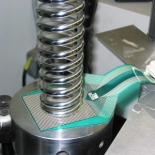Evaluate Coil Spring Pressure Distribution
Engineers can take many approaches to designing coil springs. Some designers will clip the end of the spring "square"; creating a small high-pressure point at the end of the spring that transfers load eccentrically. Other designers bend the last coil to be perpendicular to the axis or shave the last coil at the pitch angle to spread the load over a larger area. Pressure distribution can be accurately measured in each of these designs.
Challenge
Determine the pressure distribution between a coil spring and its support that enhances performance, longevity, and properly balances load.
Solution
I-Scan™ pressure mapping system can measure pressure distribution. The system's minimally intrusive sensors can be positioned under the coils to measure the contact area of the spring and any changes in contact area or pressure distribution that occur during the application of various forces. Pressure data can be viewed as 2D and 3D displays and can be used to compare coil spring designs during simulated operating conditions. Tekscan's patented, thin-film sensors are available in different shapes and sizes, are reusable, and provide accurate contact pressure measurements. With the help of our highly qualified sales and engineering support team, each system may be configured to meet your specific needs.
2D output of coil spring showing high pressure on the outside of the loaded spring. Force vs. distance graph showing higher forces on the outside of the spring. Force vs. time graph showing consistent force over the duration of the test.
Coil Spring Pressure Measurement Applications
- Research, design & development
- Compare small and large diameter coil sizes
- Determine load balance around the coil
- Life cycle assessment
- Performance testing
- Quality assurance
Benefits of Using I-Scan to Design and Test Coil Springs
- Removes guess work by putting real numbers on force, location, contact area, and pressure distribution on the end of the coil
- Assists in spring wear and linear stability predictions by showing the contact load distribution as a function of applied force
- Aids in the determination of optimum shape, thickness and materials
See how Pressure Mapping Technology can help automobile manufacturers obtain dynamic pressure data to extend the life of vehicle components, like coil springs:

